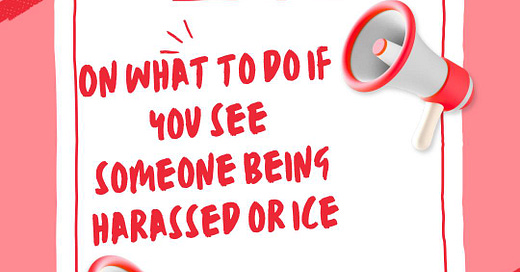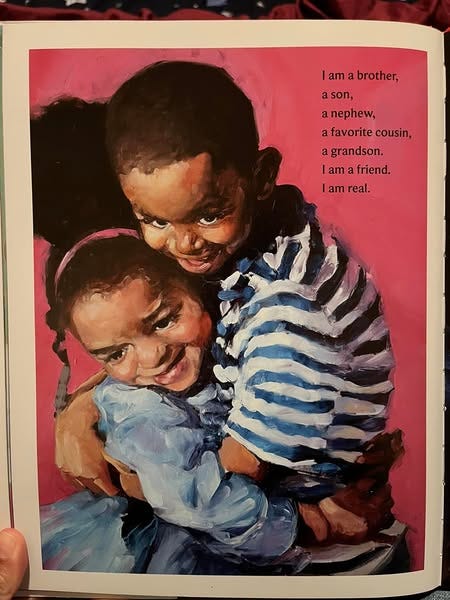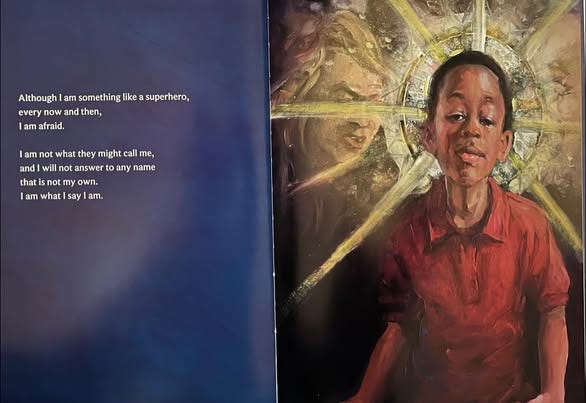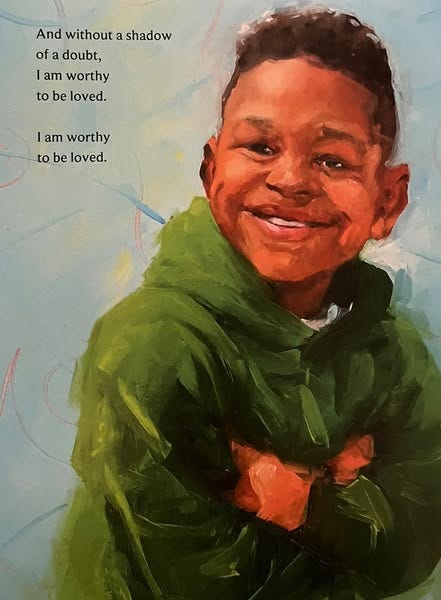Your one stop for bystander intervention in the face of harassment, and specific training for blocking ICE
And non-functional language; DOE fuckery; beautiful; care for everyone; I Am Every Good Thing; stuff to listen to
In this issue…
Trying to navigate the DOE to make sure A- has access to communication
Care in the face of care cuts - and what about those who are left out?
“We are creating something altogether, even across the country”
Bystander training (for harassment, and for ICE)
I've been trying to watch my body's sense of urgency this past week, while I take in information and try to be thoughtful about what is needed.
One thing that seems very clear is we all need to be prepared to be a bystander either for ICE, or just for hate in general.
Frankly, Daniel and I have needed this even before this moment to help us better handle hate hurled at A-, or at us as his parents (yes I’ve been physically assaulted by trying to defend A-, Daniel has been followed by a growing mob).
But now, we can assume that the dehumanization of everyone will emboldened even more people to harass and assault BIPOC people, trans people, women, people who "look different", and more.
So - we all need to have the tools and skills ready to support, in the best way possible, when we need to.
Be ready to appropriately support someone being harassed for their identity:
I recommend the Right to Be's Bystander trainings. They have a short guide to the 5Ds we should all read, and a ton of upcoming trainings, and even a training video for kids to learn to be Bystanders. There’s a book too if you prefer that format. They're a solid org and I recommend we all at least learn the 5Ds, and practice them so we're ready whether we're protecting our kids, or a stranger.
Be ready to appropriately support anyone being harassed by ICE:
And for ICE - anyone who goes into a deli or grocery store, takes public transit, works in an office - needs to be prepared for ICE to show up anywhere, at any time, especially if you live in a sanctuary city. Having been part of a lot of these trainings in past immigration work, ICE lies a LOT so learning the difference between a real judicial warrant, vs a made up piece of paper, can really be important.
You should also get connected to local immigration orgs, because there may be local ICE watch groups, detention watch, and hotlines to call to report ICE sightings in your city (never re share un-verified postings on social media with ICE sightings because they just stoke fear. Instead find a reliable hotline!)
Immigrant Defense Project has slides from their ICE Know-Your-Rights training organized by where it’s happening. Section 5, specifically, is what to do if you witness and ICE raid
Make the Road's Deportation Defense manual also goes into knowing your rights in different locations, and it has posters and print-outs to have with you or put up in locations. They also show photo examples of what a judicial warrant looks like.
And here's a cool choose your own adventure to practice your ICE bystander skills, which is important to go into action when needed.
On modeling non-functional language
We’re doing so much mixing and matching of language right now! We're keeping a list of what A- is saying, most of it is repeating back what we've been modeling, and it's pretty hilarious:
Next stop, Popcorn Avenue (there is no actual Popcorn Avenue)
Lots of steam, on Popcorn Avenue
Flatbush my teeth (made by him!)
Gentle Avenue lots of steam.
This is what we model in our family right now. "Diaper street!" was a big one this morning. "Gentle feet" has become "Gentle Feet Street".
I was thinking about a question I recently saw where someone was asking “Do you have to follow XYZ NLA (Natural Language Acquisition) rule?” And that made me think about how all the mitigations we're modeling aren't carefully designed to be functional sentences. They're fun. They're exciting. They're hilarious.
We already know A- is stage 4+, even if his expressive language doesn’t show that, so maybe that helps. But if you work with a kid with difficulty accessing speech, you don't know what stage they're in anyway. I also think that his daily recitations of every single bus stop in NYC is giving him practice pronouncing words and sounds that are meaningful to him. I think, it's possible, that saying sentences that end with his favorite "Avenue" or "Street" helps him say whatever comes before it. When he quickly says "Vitamins Avenue" and then I sllooooow it down, for the first time he is re-saying it slower, and more clearly, which isn't a thing he did before.
But the main point here is that it's fun, and we do it, and there's probably all sorts of good things that come out of it. But especially joy.
Joy is resistance.
Beautiful, beautiful, beautiful
"This woman who works here came up to me and said she loves A- he’s beautiful beautiful beautiful" - Daniel
Trying to navigate the DOE to make sure A- has access to communication
I’d just like to share that last March we got an AAC device from the DOE. (Finally - took about a year). Within a week it was broken. Not by A-. It just wouldn’t turn back on.
We still haven’t gotten a replacement. Granted, we didn’t push hard for it back then because of my dad dying. But we’ve been emailing back and forth in earnest for the last 2 months and still nothing.
Sometime recently, it seems, it switched from the CAT assistive tech team managing this to D75 (that racist district in NYC they put disabled kids into). Nobody told us that 2 months ago.
We were told to fill out a D75 form, finally, and by the third page we got a message saying this wasn’t for us because there’s still an Apple warranty on the device and to “check back later for updates”.
For us this talker is our back up, and the one we’d use to model. So while it’s important it isn’t holding A- back from communicating. For others, their kid would be unable to speak.
I could, of course, call them, fax them, snail mail them postcards until they pay attention but my to do list is now out of control, and my emotional capacity to do things the exact opposite.
Care in the face of care cuts - and what about those who are left out?
A great article to orient disabled people and their allies towards community care in the face of (further) care cuts.
What I am still curious about, if any of my followers especially new ones know about, is what resources talk about community care in a way that includes the most marginalized (the ones who can’t ask for what they need? The ones who can’t organise as part of a collective?). I know in Care Work they acknowledge this population of disabled people left out of the convo, but not with solutions.
Swirling in the back of my brain during the last month of Visioning is the idea that I have to be a care supporter - we all do. We have to be putting our energy towards that. Because across all facets - our trans community, our undocumented community - are people who need one on one care and won’t be able to access it or never have. And ultimately we are revolutionary when we commit - in our daily lives - to living a world in which nobody is disposable and everyone is worthy. (Except right now I sort of am? But future Shubha, anyway).
I Am Every Good Thing by Derrick Barnes
I’ve shared this amazing book before but it needs to be shared many times. It’s the Black affirmation book, especially for multiple marginalized kids like A-. I can’t read it without crying.
Although I am something like a superhero, every now and then, I am afraid.
I am not what they might call me, and I will not answer to any name that is not my own.
I am what I say I am.
And without a shadow of a doubt, I am worthy to be loved.
I am worthy to be loved.
“We are creating something altogether, even across the country”
I feel like the stories we need to elevate and pay attention to in this moment are when people are fighting against the dehumanization of those who have always, and newly, been dehumanized.
I’m always excited to learn about people throughout the world, throughout history, doing this through connection and community.
A social media friend, Sarah Cooper Evans msgd me the other day:
“I am a speech language, pathologist in Minneapolis Public schools and working on a project related to AAC /caregivers/cultural meaning and relevance for families, and hopefully making some videos and hosting caregiver circles for families to be with one another. Today I shared your website and resources as we ended the meeting telling others they could leave as they needed, listening to “you are not alone” and looking at the stories that you shared in “A Year of Multimodal Communication.” every single person stayed and I got super teary. Thank you. I don’t know what’s coming next but I feel we are creating something altogether even across the country.”
Some stuff to read, listen to, know about
This playlist was put out by, I think Kundiman, 8 years ago. And I listened to it on loop for months. I wrote out lyrics to songs and put them on our wall. I’ve still pulled it back out from time to time, but, of course, much more often now:
This playlist was created by me and a friend about 5 years ago when we got our citizenship. It includes some of the songs from the Radical love playlist! And a big range of songs about capitalism, America, fighting, winning.
This great Prentis Hemphill interview with Maurice Mitchell on visioning, staying focused on your vision, left strategy, and the need to move to connection (as a strategy).
"I've rarely found a binary that actually reflects my experience of reality, or a binary where the people that I care deeply about don't happen to be on the bottom of it." - Maurice Mitchell









